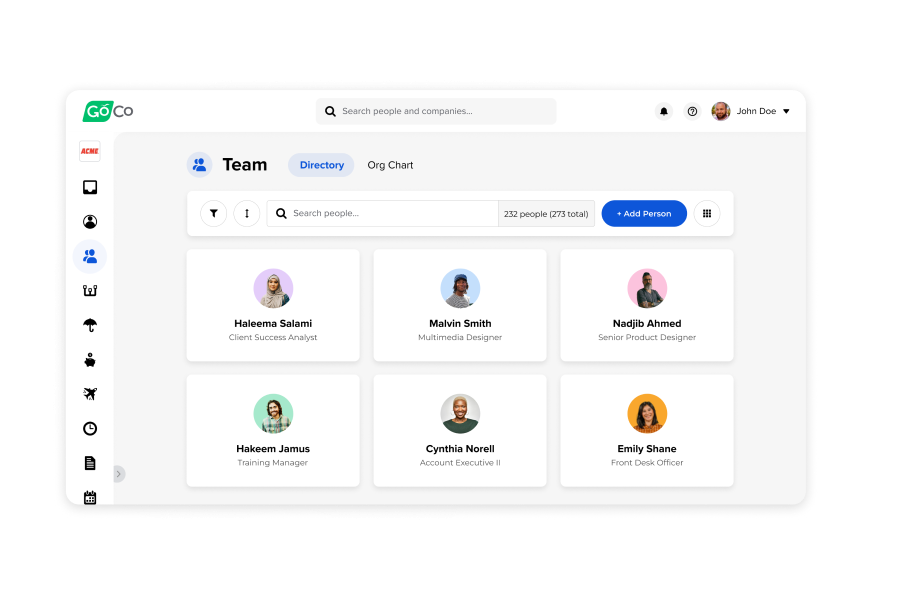8 Challenges Faced During the PEO to HRIS Transition
Explore the experiences of eight business leaders who transitioned their organizations from a PEO to an HRIS.
December 13th, 2023
Switching your organization from a PEO to an HRIS is a daunting task that many companies have been through and learned from. In this article, we explore the experiences of eight leaders who transitioned their organizations from a PEO to an HRIS. Our contributors, including founders and CEOs, share their insights on their experiences, from balancing benefits and challenges in transition to investing in training for HRIS adoption. Read on to learn from their experiences and gain valuable insights for your own transition.
Balancing Benefits and Challenges in Transition
Transitioning from a PEO to an HRIS was a pivotal move for our high-performing software technology company. The switch mirrored our company's evolution, much like upgrading from a basic toolkit to a Swiss Army knife. We realized that an HRIS offered enhanced scalability, which was especially beneficial given our expanding operations.
One statistic that stands out is a noticeable 30% improvement in our HR process efficiencies within the first six months. In hindsight, I wish we had a deeper understanding of the integration complexities beforehand. The integration phase was akin to syncing different gears of a watch - requiring precision.
But, with challenges came learning. It underscored the importance of thorough training and understanding every nuance of the system for seamless execution. The journey was enlightening, emphasizing that the right tools can indeed catalyze growth.
Ankit Prakash, Founder, Sprout24
Planning and Training for Integration Complexity
Transitioning was a significant strategic move. The main learning was about integration complexity. While an HRIS offers autonomy and scalability, integrating it seamlessly requires meticulous planning.
Our initial oversight was underestimating the time and effort for data migration. We faced challenges in transferring employee records, benefits data, and payroll details without discrepancies. In hindsight, I wish we had invested more in training our HR personnel on the HRIS platform beforehand. A smoother transition would have resulted from prior familiarity with the system's intricacies.
For businesses contemplating a similar shift, ensure a robust migration plan, allocate ample time for the process, and prioritize training. Having a dedicated transition team, even if temporary, can also make a world of difference.
Zain Ali, Partner, EVENSKYN
Optimizing HR Operations with HRIS
Our practice's transition was a significant change. It enabled us to optimize and exert greater control over our HR operations.
We learned the importance of thorough planning and data migration as a vital lesson. It was crucial to ensure a seamless transition of employee records and payroll data to prevent disruptions. In addition, educating the staff on the new HRIS was necessary to maximize its benefits.
In retrospect, we wished we had implemented the HRIS sooner because it afforded us greater flexibility and customization options for administering our HR requirements. It enabled us to manage HR tasks more efficiently in-house and to tailor processes to our practice's specific needs.
Overall, the transformation improved HR autonomy and efficiency. It stressed the importance of a well-executed change management plan and full HR process oversight.
Dr. Jennifer Silver, CEO, Owner, and Dentist, MACLEOD TRAIL DENTAL
Prioritizing Data Integrity and Staff Readiness
Transitioning from a PEO to an HRIS was a pivotal shift for our organization. While the PEO offered comprehensive services, the HRIS gave us more control and customization. The process demanded thorough data migration and retraining.
In hindsight, I wish we'd anticipated the steep learning curve and allocated more resources for training. Engaging with a dedicated implementation specialist earlier would have streamlined the shift. It's crucial to prioritize data integrity and staff readiness when making such a transition.
Ranee Zhang, VP of Growth, Airgram
Ensuring Requirements are Met, Preparing for Issues
Transitioning from a PEO (Professional Employer Organization) to an HRIS (Human Resources Information System) can provide several benefits, but it also presents certain obstacles. I observed increased internal control over HR functions, enhanced data administration, and increased scalability.
I also learned some significant lessons. First, careful planning is essential. Ensure that your HRIS implementation correlates with your organization's unique requirements and that your employees are properly trained to use the system.
Second, during the transition, be prepared for potential data migration issues. It is essential to ensure the accuracy and integrity of data.
Finally, communication is essential. Keep employees informed throughout the duration of the process, and promptly address any concerns.
Overall, the transition can be beneficial, but it requires cautious planning and execution to maximize its advantages and minimize disruptions.
John Truong, Managing Director and Attorney, Alliance Compensation & Litigation Lawyers
Harnessing Data Analysis and Managing Changeover
In today's data-driven world, an HRIS gives us more data analysis capabilities than our former PEO. This allows us to predict and reduce churn while increasing our capability to find the best talent. However, the longer you stick with a system, the more employees become accustomed to its use. Navigating a changeover slowly, yet not so slowly that you lose momentum, is a challenge.
I wish we had a more detailed plan to ensure everyone started and remained on board with this essential shift.
Corey Donovan, President, Alta Technologies
Mastering Customization and Communication
Moving to an HRIS from a PEO was quite an easy transition. At first, we were concerned about the level of customization that we would need to address. But as it turns out, an HRIS is more customizable, it's easier to use, and it's more thorough, so no information slips through the cracks.
Before you decide to switch to an HRIS, however, you do need to note that since this system is significantly more customizable than a PEO, you should have an organizational game plan in place so you're not overwhelmed by the amount of data there is to sift through.
An HRIS also requires more involvement, which isn't a bad thing if you're looking to step away from the all-encompassing PEO platform. Be ready to open the lines of communication with staff and adopt a platform that requires direct human involvement.
Sean Coffey, Marketing Manager, Regency Fire
Investing in Training for HRIS Adoption
Try not to emphasize too much prior knowledge when training HR staff on the new system. Chances are, they're dealing with something fundamentally different from their previous PEO.
A full-fledged training session that may last a few days is a good way to start off on the right foot. PEOs and HRISes carry many similar functions, but thinking of an HRIS as a PEO with additional functionality misses the point. What it does is advance your HR efforts in an entirely new way. To get the full value from your investment, you must invest in training as well.
Mark Varnas, Principal SQL Server DBA and Consultant, Red9
Final Thoughts
The transition from a PEO to an HRIS is a transformative journey that demands careful planning, strategic decision-making, and a commitment to ongoing training. The insights shared by the eight leaders in this article underscore the significant benefits of the shift, such as increased control, scalability, and data analysis capabilities. However, they also emphasize the importance of anticipating challenges, such as integration complexities, data migration issues, and a potential learning curve for staff.
These experiences stress the need for meticulous planning, prioritizing data integrity, and investing in comprehensive training to ensure a seamless transition. As organizations consider making this pivotal shift, these valuable insights serve as a guide, offering lessons learned and best practices to navigate the path toward enhanced HR autonomy and efficiency.

Subscribe to Beyond The Desk to get insights, important dates, and a healthy dose of HR fun straight to your inbox.
Subscribe hereRecommended Posts
A Comprehensive Guide to Switching from a PEO to an HRIS
Blog Articles
Getting Buy-in as an HR Leader
Webinars







